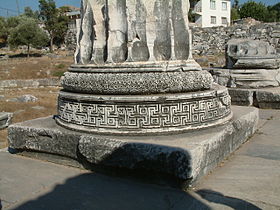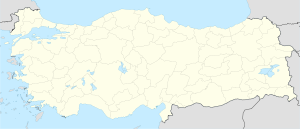- Didyma
-
Didyma(Δίδυμα)
(Didim)Enriched mouldings from the third-century rebuilding Didyma (Greek: Δίδυμα) was an ancient Ionian sanctuary, the modern Didim, Turkey,[1] containing a temple and oracle of Apollo, the Didymaion. In Greek didyma means "twin", but the Greeks who sought a "twin" at Didyma ignored the Carian origin of the name.[2] Next to Delphi, Didyma was the most renowned oracle of the Hellenic world, first mentioned among the Greeks in the Homeric Hymn to Apollo,[3] but an establishment preceding literacy and even the Hellenic colonization of Ionia. Mythic genealogies of the origins of the Branchidae line of priests, designed to capture the origins of Didyma as a Hellenic tradition, date to the Hellenistic period.[4]
Didyma was the largest and most significant sanctuary on the territory of the great classical city Miletus. To approach it, visitors would follow the Sacred Way to Didyma, about 17 km long. Along the way, were ritual waystations, and statues of members of the Branchidae family, male and female, as well as animal figures. Some of these statues, dating to the 6th century BC are now in the British Museum, taken by Charles Newton in the 19th century.
Greek and Roman authors laboured to refer the name Didyma to "twin" temples — not a feature of the site — or to temples of the twins, Apollo and Artemis, whose own cult center at Didyma was only recently established, or whether, as Wilamowitz suggested[5] there is a connection to Cybele Dindymene, "Cybele of Mount Dindymon", is mooted. Recent excavations by the German team of archaeologists have uncovered a major sanctuary dedicated to Artemis, with the key ritual focus being water.
The 6th-century Didymaion, dedicated to Apollo, enclosed its smaller predecessor, which archaeologists have identified. Its treasury was enriched by gifts from Croesus.
Contents
The Branchidae
Until its destruction by the Persians in 494 BC, Didyma's sanctuary was administered by the family of the Branchidae, who claimed descent from a purely eponymous Branchos,[6] a youth beloved of Apollo.[7] The priestess, seated above the sacred spring, gave utterances that were interpreted by the Branchidae. Both Herodotus[8] and Pausanias[9] dated the origins of the oracle at Didyma before the Ionian colonization of this coast. The Branchidae were expelled by Darius' Persians, who burned the temple in 493 BC and carried away to Ecbatana the archaic bronze statue of Apollo, traditionally made by Canachus of Sicyon[10] in the 6th century; the spring dried up, it was reported, and the archaic oracle was silenced.[11] Though the sanctuaries of Delphi and Ephesus were swiftly rebuilt, Didyma remained a ruin until the first steps of restoration were undertaken, in 334 BC. Callisthenes, a court historian of Alexander reported that the spring began once more to flow after Alexander passed through, but there had been a complete break in the oracles' personnel and tradition.[12] Inscriptions, including inquiries and responses, and literary testimony record Didyma's role as an oracle, with the "grim epilogue"[13] of Apollo's supposed sanction of Diocletian's persecution of Christians, until the closing of the temples under Theodosius I.
After his capture of Miletus in 334 BC Alexander the Great reconsecrated the oracle but placed its administration of the oracle in the hands of the city, where the priest in charge was annually elected. About 300 BC[14] Seleucus I Nicator brought the bronze cult image back, and the Milesians began to build a new temple, which, if it had ever been completed, would have been the largest in the Hellenic world. Vitruvius recorded a tradition that the architects were Paeonius of Ephesus, whom Vitruvius credited with the rebuilding of the Temple of Artemis there, and Daphnis of Miletus. The peripteral temple[15] was surrounded by a double file of Ionic columns. With a pronaos of three rows of four columns, the approaching visitor passed through a regularized grove formed of columns. The usual door leading to a cella was replaced by a blank wall with a large upper opening through which one could glimpse the upper part of the naiskos in the inner court (adyton). The entry route lay down either of two long constricted sloping passageways built within the thickness of the walls which gave access to the inner court, still open to the sky but isolated from the world by the high walls of the cella: there was the ancient spring, the naiskos— which was a small temple itself, containing in its own small cella the bronze cult image of the god— and a grove of laurels, sacred to Apollo. The inner walls of the cella were articulated by pilasters standing on a base the height of a man (1.94 m). Turning back again, the visitor saw a monumental staircase that led up to three openings to a room[16] whose roof was supported by two columns on the central cross-axis. The oracular procedure, so well documented at Delphi, is unknown at Didyma and must be reconstructed on the basis of the temple's construction, but it appears that several features of Delphi were now adopted: a priestess[17] and answers delivered in classical hexameters. At Delphi, nothing was written; at Didyma, inquiries and answers were written; a small structure, the Chresmographion featured in this process: it was meticulously disassembled in the Christian period.
The annual festival held there under the auspices of Miletus was the Didymeia; it was made a Panhellenic festival in the beginning of the 2nd century BC. German excavations made between 1905 and 1930 revealed all of the incomplete new temple and some carved fragments that belonged to the earlier temple and to associated statues.
Pausanias visited Didyma in the later 2nd century AD.[18] Pliny reported[19] the worship of Apollo Didymiae, Apollo of Didymus, in Central Asia, transported to Sogdiana by a general of Seleucus and Antiochus whose inscribed altars there were still to be seen by Pliny's correspondents. Corroborating inscriptions on amphoras were found by I.R. Pichikyan at Dilbergin.[20]
Clement of Alexandria quotes Leandrios saying that Cleochus, grandfather of the eponymous founder Miletus, was buried within the temple enclosure of Didyma.[21]
Notes
- ^ Didim is located near the modern village of Yeni Hisar (Yoran), close to the Turkish resort of Altinkum, near the town of Söke in the province of Aydın.
- ^ Didyma is akin to Idyma in Caria, and Sidyma in Lycia, Joseph Eddy Fontenrose noted (Fontenrose, "Zeus Didymaeus", Transactions and Proceedings of the American Philological Association 63 (1932, pp. 245-255) p 251).
- ^ Fontenrose 1932:245 demonstrates that a "Zeus Didymeus" that was mentioned once, by Nicander, is a phantom based on a merely geographical epithet: the Zeus who shared honors of patronage at Didyma, though not in the Didymaion itself, was actually Zeus Soter, "Zeus the Saviour".
- ^ H. W. Parke, "The Temple of Apollo at Didyma: The Building and Its Function" The Journal of Hellenic Studies 106 (1986, pp. 121-131) p 123.
- ^ Wilamowitz-Moellendorff, "Die Herkunft am Magneten-um-Maeander" Hermes 30 (1895), p 181, taking a cue from the suggestion in Strabo that the Magnesians came from the region round Mount Didyma in Thessaly and erected in their new home a temple to Dindymene, "Mother of the Gods", i.e. Cybele.
- ^ Bragxos, βράγχος, "hoarse" (Hammond 1998:339 note 1.
- ^ Strabo, 634.
- ^ Herodotus, Histories 1.157.3.
- ^ Pausanias, 7.2.6.
- ^ Pausanias, 2.10.5.
- ^ Parke reports that the adyton is normally dry today.
- ^ Parke 1986.
- ^ Robert Parker, reviewing Fontenrose 1988 in The Classical Review New Series 39.2 (1989), p 270.
- ^ Pausanias (i.16.3, viii.46.3) offers no date, but Seleucus gained control of Media in the years immediately after 312.
- ^ This description follows that of Parke 1986:21-131.
- ^ Its rear wall divided it from the pronaos outside.
- ^ Iamblychus' profetis (in De mysteriis)
- ^ Pausanias. Description of Greece, 7.2.6.
- ^ Pliny's Natural History, 6.18.
- ^ Pichikyan publication (1991) noted in Hammond 1998:339 note 2.
- ^ Clement Alexandrinus. Protrepticus, 3.45.2-3.
See also
References
- Hammond, N. G. L. 1998. "The Branchidae at Didyma and in Sogdiana" The Classical Quarterly, New Series, 48.2 pp. 339–344.
External links
- Encyclopedia Iranica, "Didyma"
- Didyma Apollon Temple Turkey
- Livius Picture Archive: Didyma (Yenihisar)
- Didyma article by archaeologist Peter Sommer
- Site of Didyma
- Richard Stillwell, ed. Princeton Encyclopedia of Classical Sites, 1976: "Didyma,or Branchidai (Didim, previously Yoran) Turkey"
- Rather exhaustive picture series of Didyma
Further reading
- Joseph Fontenrose, 1988. Didyma. Apollo's Oracle, Cult and Companions, (Berkeley). Catalogue of Didyman inquiries and responses, translated.
- Robin Lane Fox, Pagans and Christians 1986: Chapter 5.
- H. W. Parke, 1985. The Oracles of Apollo in Asia Minor
- T. Wiegand, 1941-58. Didyma, 2 vols. in 4, (Berlin) The prime archaeological report.
Coordinates: 37°23′06″N 27°15′23″E / 37.384962°N 27.256430°E
 Ancient settlements in Turkey
Ancient settlements in TurkeyAegean Aegae · Alabanda · Alinda · Allianoi · Amorium · Amyzon · Antioch on the Maeander · Apamea in Phrygia · Aphrodisias · Apollonia in Mysia · Atarneus · Beycesultan · Caryanda · Celaenae · Ceramus · Colophon · Cyme · Didyma · Docimium · Ephesus · Erythrae · Euromus · Gambrion · Gryneion · Halicarnassus · Hierapolis · Iasos · Kaunos · Kayaköy · Klazomenai · Knidos · Laodicea on the Lycus · Latmus · Lebedus · Limantepe · Magnesia on the Maeander · Metropolis · Miletus · Myndus · Myriandrus · Myus · Notion · Nysa · Oenoanda · Orestias · Pepuza · Pergamon · Perperene · Phocaea · Pinara · Pitane · Priene · Sardis · Sigeion · Smyrna · Stratonicea in Lydia · Stratonicea in Caria · Temnos · Teos · TymionBlack Sea Alaca Höyük · Comana in the Pontus · Euchaita · Hattusa · Hüseyindede Tepe · Ibora · Laodicea Pontica · Nerik · Nicopolis · Pompeiopolis · Salatiwara · Samuha · Sapinuwa · Tripolis · Yazılıkaya · ZalichesCentral Anatolia Alişar Hüyük · Çatalhöyük · Derbe · Dorylaeum · Gordium · Heraclea Cybistra · Irenopolis · Kaman-Kalehöyük · Kerkenes · Kültepe · Laodicea Combusta · Mokissos · Nyssa · Pessinus · Purushanda · Tavium · TyanaEastern Anatolia Marmara Aegospotami · Alexandria Troas · Apamea Myrlea · Apollonia on the Rhyndax · Apros · Assos · Cardia · Cebrene · Chalcedon · Cius · Cyzicus · Drusipara · Faustinopolis · Germanicopolis · Lysimachia · Nicomedia · Sestos · Skepsis · Troy (Hisarlik)Mediterranean Alalakh · Anazarbus · Antigonia · Antioch on the Orontes · Antioch in Pisidia · Antiochia Lamotis · Antioch on the Cragus · Antioch on the Pyramis · Aphrodisias of Cilicia · Ariassos · Arsinoe · Arycanda · Aspendos · Comana in Cappadocia · Corycus (Kızkalesi) · Cremna · Cyrrhus · Domuztepe · Elaiussa Sebaste · Epiphania · Gözlükule · Hacilar · Issus · Kandyba · Karatepe · Kibyra · Mallus · Mamure Castle · Mopsuestia · Myra · Olba · Patara · Perga · Phaselis · Rhosus · Sagalassos · Seleucia in Pamphylia · Seleucia Pieria · Seleucia Sidera · Selge · Side · Sillyon · Soli · Sozopolis · Tell Tayinat · Termessos · Tlos · Xanthos · YumuktepeSoutheastern Anatolia Antioch in the Taurus · Antioch in Mesopotamia · Apamea on the Euphrates · Carchemish · Çayönü · Dara · Edessa · Göbeklitepe · Harran · Kussara · Nevalı Çori · Sakçagözü · Sam'al · Samosata · Sareisa · Seleucia at the Zeugma · Sultantepe · Tille · Tushhan · ZeugmaCategories:- Classical oracles
- Ancient Greek cities
- Archaeological sites in Turkey
- History of Aydın Province
Wikimedia Foundation. 2010.




